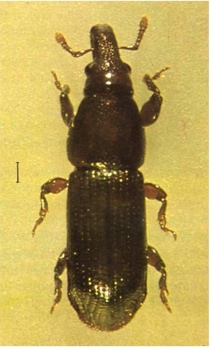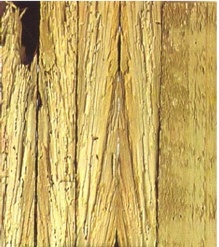PESTS AND DISEASES OF FORESTRY IN NEW ZEALAND
Torostoma apicale, a native wood-boring weevil
Scion is the leading provider of forest-related knowledge in New Zealand
Formerly known as the Forest Research Institute, Scion has been a leader in research relating to forest health for over 50 years. The Rotorua-based Crown Research Institute continues to provide science that will protect all forests from damage caused by insect pests, pathogens and weeds. The information presented below arises from these research activities.
Forest and Timber Insects in New Zealand No. 38: A native wood-boring weevil.
Revised 2009
Based on R.H. Milligan (1979)
Insect: Torostoma apicale Broun (Coleoptera: Curculionidae)

Fig. 1 - Torostoma apicale adult. The line shows natural length.
Type of injury
The larvae of the weevil Torostoma apicale feed in both sapwood and heartwood of building timbers which have long been seasoned, and sometimes damage sawn timber during seasoning.
In the forest they occur in logs, in the dead wood of standing stems, and in dead branches and twigs of living trees. Larval tunnels are mostly parallel with the grain of the wood and are loosely packed with fine faecal pellets. Ultimately the tunnels may reduce the wood to a series of lamellae. The exit holes are smaller than those of the house borer Anobium punctatum, usually more or less circular, but sometimes slotted at opposite sides or otherwise irregular in outline (Fig. 2).

Fig. 2 - Workings and exit holes of T. apicale in radiata pine board (x3/8)
Hosts
Damage has been recorded in building timbers sawn from Agathis australis (kauri), Dacrydium cupressinum (rimu), Dacrycarpus dacrydioides (kahikatea), Prumnopitys taxifolia (matai), Podocarpus totara (totara), Pinus radiata (radiata pine), and Pseudotsuga menziesii (Douglas fir). It has been found in a wide variety of dead trees and shrubs in the forest.
Distribution
This native weevil is believed to be distributed throughout New Zealand, but it may be more common in those parts which have a humid summer climate.
Economic importance
Though it may locally contribute to damage in building timbers which have not been treated with preservatives, it is found much less frequently than the house borers Anobium punctatum and Leanobium flavomaculatum (Anobiidae), or the two-toothed longhorn Ambeodontus tristis (Cerambycidae). Damage is probably rarer and less important than that of the New Zealand drywood termite Kalotermes brouni (Kalotermitidae) or the large borer beetle Hadrobregmus magnus (Anobiidae). Damage in seasoning radiata pine is usually found in association with sapstain fungi, but it is not known whether T. apicale disseminates sapstain, or whether it prefers sapstained parts.
Description, life history, and habits
The adult (Fig. 1) is dark brown, up to 6 mm long, and 1.5 mm wide. The head extends in line with the body, and is drawn out in front of the eyes to form a snout which bears a pair of elbowed antennae attached near its mid-point. Each antenna consists of a stout, elongate first segment followed by a series of five short ones lying more or less at right angles, and ends in an oval club which is paler than the rest.
The prothorax is as wide as the elytra (wing cases), but narrows towards the front to the same width as the head. Both the head and the prothorax are densely and irregularly pitted.
The elytra are constricted at their front edges, forming a distinct waist which is accentuated by the rounded rear corners of the prothorax. The surface of the elytra is longitudinally ribbed, with rows of pits between the ribs. The rear edge of each elytron is expanded, forming a horizontal shelf from the middle to the outer corner. The extent of this flanging helps to distinguish T. apicale from other native members of the weevil subfamily Cossoninae.
The larva is a pale, curved, legless grub, not readily distinguished from those of other small weevils.
On building timber, T. apicale lays eggs on rough-sawn surfaces or in holes from which previous generations have emerged.
The life history of this insect has not been studied, but a similar cossonine weevil has been found to pass through five larval stages in 6–8 months when reared at 25°C and 95–100% relative humidity in the laboratory (Hammad, 1955), and Kelsey (1946) considered it probable that the life cycle of T. apicale under natural conditions is completed in a year.
In New Zealand the Cossoninae are represented by an unusually large number of species; 132 species placed in over 30 genera have been described. Most occur in wet decaying wood, or under bark, and only T apicale is found to damage buildings. In the United Kingdom, however, two New Zealand species, Euophryum confine and E. rufum, which have been accidentally introduced are now widely distributed and are of some economic importance because of their damage to building timbers, especially in cellars and other damp, poorly ventilated situations.
Control
Measures specifically for the control of T. apicale damage in buildings or in timber seasoning yards have not been required. Prevention of damage by this and other wood borers is most satisfactorily obtained by the consistent use of preservative-treated timbers in new buildings. No parasites or predators of T. apicale have been recorded.
References
Hammad, S.M. 1955: The immature stages of Pentarthrum huttoni Woll. (Coleoptera: Curculionidae). Proceedings of the Royal Entomological Society, London, (A) 30: 33-39.
Hickin, N.E. 1975: The insect factor in wood decay. 3rd ed. (rev.). Associated Business Programmes Ltd, London. 383 p.
Kelsey, J.M. 1946: Insects attacking milled timber, poles and posts in New Zealand. New Zealand Journal of Science and Technology 28 (8): 65-100.
Milligan, R.H. 1979: Torostoma apicale Broun (Coleoptera: Curculionidae). A native wood-boring weevil. New Zealand Forest Service, Forest and Timber Insects in New Zealand No. 38.
This information is intended for general interest only. It is not intended to be a substitute for specific specialist advice on any matter and should not be relied on for that purpose. Scion will not be liable for any direct, indirect, incidental, special, consequential or exemplary damages, loss of profits, or any other intangible losses that result from using the information provided on this site.
(Scion is the trading name of the New Zealand Forest Research Institute Limited.)



